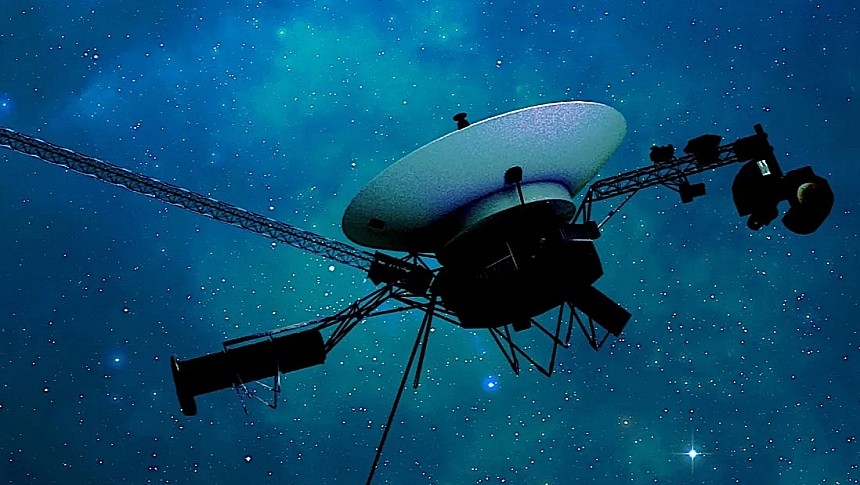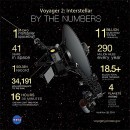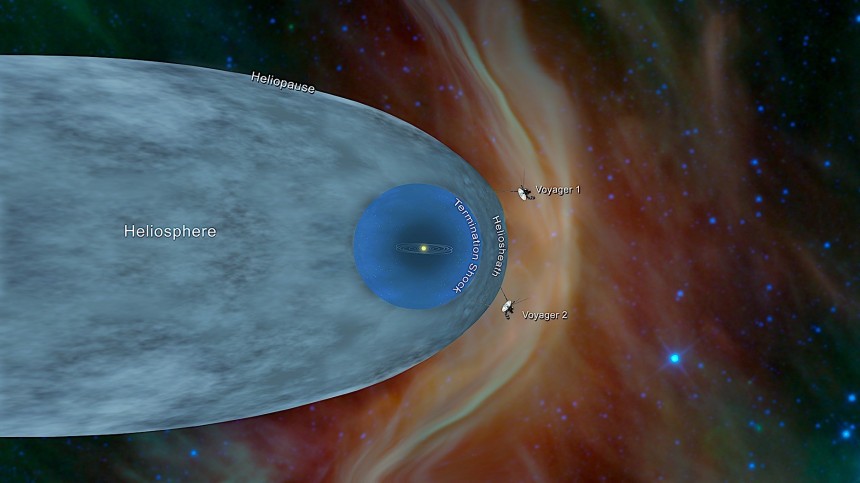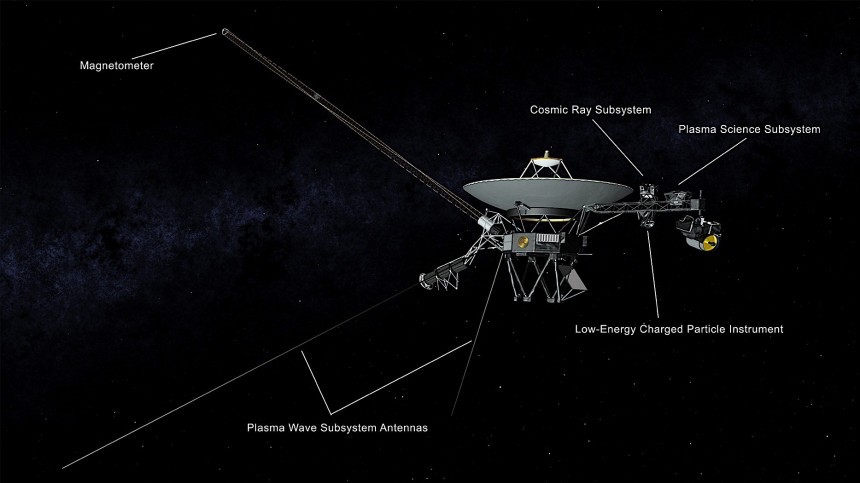You may be fooled into believing that the large number of spacecraft we've sent beyond the borders of our planet makes us a sort of interplanetary civilization. If you really think about it, though, we've only stepped timidly into our immediate neighborhood.
The large majority of spacecraft launched from Earth have only made it as far as the near orbit. A handful of them have reached the Moon, even fewer have made it to Mars, and fewer still have reached the distant Lagrange points.
It's generally agreed that humanity has sent up over the years over 15,000 objects of all shapes and sizes. I gave you that number just so you know how small the fact that only two of them reached the heliosphere makes us.
The heliosphere is technically the boundary separating our solar system from interstellar space, the true beginning of a journey to other star systems. The only two ships that have ever made it there are Voyager 1 and Voyager 2.
Somewhat ironically, Voyager 2 departed our planet first, in August 1977, followed a month later by Voyager 1. Their main mission was to study Jupiter and Saturn, the rings there and moons. They were only supposed to be operational for four years.
Yet here we are, 46 years later, and the two are still alive and kicking, at distances the human mind has an extremely difficult time comprehending: 15 billion miles (24.1 billion km, Voyager 1) and 12 billion miles (19.3 billion km, Voyager 2).
The two adopted separate paths on their way out of the solar system. Voyager 2 became in 1990 the first (and to date the only) human spacecraft to visit ice giants Uranus and Neptune, and reached the heliosphere in 2018. Voyager 1 took the shorter route and traveled faster, arriving at the edge of the solar system six years prior.
No matter how advanced we think we are, there is technically little we know of what lies beyond Sol. The presence of these two ships in interstellar space makes them highly valuable, and that's why NASA decided to keep them going for a while longer, at least for the next five years.
To do that the ships will have to be updated, especially given how the long time in space is taking its toll and they are beginning to show signs of wear and tear.
More specifically, the lines that send fuel to the thrusters seem to have become filled with residue, and if something isn't done fast, they could get all clogged up. If that happens, some of the ships' thrusters will stop firing.
These thrusters are used by the two Voyagers to keep their antennas pointed toward Earth, so that humans can keep communicating with them. If they stopped firing, the spacecraft would have a big chance of becoming nothing more than space debris, floating very far away from home.
This issue is attributed to the fact the fuel lines do not have the same diameter for their entire length, and at one point they become 25 times narrower than they used to be. Repeated firings end up leaving behind propellant residue, which over decades has built up into a potential problem.
To fix the issue (actually, to slow the buildup process down, as there's no way to remove the residue already there) NASA announced this week it is changing the way it operates the Voyagers, allowing them to rotate farther in each direction before firing the thrusters. This way, fewer burns will be required for corrections.
A separate procedure to be performed involves a software update to the ships' computer. It's called for to prevent a glitch that had Voyager 1 send back garbled data about its status last year, due to a fault in the attitude articulation and control system (AACS).
The software upgrade will be performed imminently. On October 20 NASA uploaded the software patch and is in the process of making sure it works as planned. On October 28, the first command will be given to see if it everything checks out.
Out of precaution, and as a means to avoid accidental overwrite of the spacecraft essential code, the space agency decided to try the software fix on the Voyager 2 first. Being closer to Earth, it's considered less valuable than its sibling. If all goes well, the upgrade will be sent over to Voyager 1 as well.
It may sound simple, but it's really not. Just to give you a sense of how daunting the whole process is, keep in mind that because of the distances involved, any command (and over-the-air updates) requires at least 18 hours to reach the two ships.
As is, the two Voyagers are well on their way to spending more than half a century in space. But they won't stop there: NASA promises that if all goes according to plan with these fixes, it can take additional steps in the coming years to extend the lifetime of the thrusters even more.
It's generally agreed that humanity has sent up over the years over 15,000 objects of all shapes and sizes. I gave you that number just so you know how small the fact that only two of them reached the heliosphere makes us.
The heliosphere is technically the boundary separating our solar system from interstellar space, the true beginning of a journey to other star systems. The only two ships that have ever made it there are Voyager 1 and Voyager 2.
Somewhat ironically, Voyager 2 departed our planet first, in August 1977, followed a month later by Voyager 1. Their main mission was to study Jupiter and Saturn, the rings there and moons. They were only supposed to be operational for four years.
Yet here we are, 46 years later, and the two are still alive and kicking, at distances the human mind has an extremely difficult time comprehending: 15 billion miles (24.1 billion km, Voyager 1) and 12 billion miles (19.3 billion km, Voyager 2).
The two adopted separate paths on their way out of the solar system. Voyager 2 became in 1990 the first (and to date the only) human spacecraft to visit ice giants Uranus and Neptune, and reached the heliosphere in 2018. Voyager 1 took the shorter route and traveled faster, arriving at the edge of the solar system six years prior.
To do that the ships will have to be updated, especially given how the long time in space is taking its toll and they are beginning to show signs of wear and tear.
More specifically, the lines that send fuel to the thrusters seem to have become filled with residue, and if something isn't done fast, they could get all clogged up. If that happens, some of the ships' thrusters will stop firing.
These thrusters are used by the two Voyagers to keep their antennas pointed toward Earth, so that humans can keep communicating with them. If they stopped firing, the spacecraft would have a big chance of becoming nothing more than space debris, floating very far away from home.
This issue is attributed to the fact the fuel lines do not have the same diameter for their entire length, and at one point they become 25 times narrower than they used to be. Repeated firings end up leaving behind propellant residue, which over decades has built up into a potential problem.
To fix the issue (actually, to slow the buildup process down, as there's no way to remove the residue already there) NASA announced this week it is changing the way it operates the Voyagers, allowing them to rotate farther in each direction before firing the thrusters. This way, fewer burns will be required for corrections.
The software upgrade will be performed imminently. On October 20 NASA uploaded the software patch and is in the process of making sure it works as planned. On October 28, the first command will be given to see if it everything checks out.
Out of precaution, and as a means to avoid accidental overwrite of the spacecraft essential code, the space agency decided to try the software fix on the Voyager 2 first. Being closer to Earth, it's considered less valuable than its sibling. If all goes well, the upgrade will be sent over to Voyager 1 as well.
It may sound simple, but it's really not. Just to give you a sense of how daunting the whole process is, keep in mind that because of the distances involved, any command (and over-the-air updates) requires at least 18 hours to reach the two ships.
As is, the two Voyagers are well on their way to spending more than half a century in space. But they won't stop there: NASA promises that if all goes according to plan with these fixes, it can take additional steps in the coming years to extend the lifetime of the thrusters even more.










